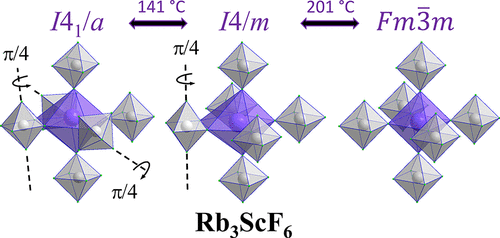Ask for a reprint
email :
* Give your email
2021
ACL
|
A.Rakhmatullin, M.S.Molokeev, G.King, I.B.Polovov, K.V.Maksimtsev, E.Chesneau, E.Suard, R.Bakirov, F.Šimko, C.Bessada, M.Allix, 'Polymorphs of Rb3ScF6: X-ray and neutron diffraction, solid-state NMR, and DFT calculations study', Inorg. Chem. 60 6016–6026 (2021) doi:10.1021/acs.inorgchem.1c00485
The crystal structures of three polymorphs of Rb3ScF6 have been determined through a combination of synchrotron, laboratory X-ray, and neutron powder diffraction, electron diffraction, and multinuclear high-field solid-state NMR studies. The room temperature (RT; α) and medium-temperature (β) structures are tetragonal, with space groups I41/a (Z = 80) and I4/m (Z = 10) and lattice parameters a = 20.2561(4) Å, c = 36.5160(0) Å and a = 14.4093(2) Å, c = 9.2015(1) Å at RT and 187 °C, respectively. The high-temperature (γ) structure is cubic space group Fm3̅m (Z = 4) with a = 9.1944(1) Å at 250 °C. The temperatures of the phase transitions were measured at 141 and 201 °C. The three α, β, and γ Rb3ScF6 phases are isostructural with the α, β, and δ forms of the potassium cryolite. Detailed structural characterizations were performed by density functional theory as well as NMR. In the case of the β polymorph, the dynamic rotations of the ScF6 octahedra of both Sc crystallographic sites have been detailed.
|

|